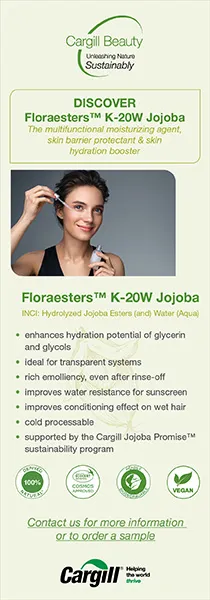Purdue University finds “extremely alarming” airborne health hazards in daily hair care routines

30 Nov 2023 --- Purdue University sees problems with daily hair care routines. According to its scientific research, inhaling milligrams of chemicals present in common hair care products can persist in the air, posing potential hazards for individuals during their routine grooming sessions, especially when using heated tools.
Led by Assistant Professor Nusrat Jung from the Lyles School of Civil Engineering and published in the journal Environmental Science & Technology, the study shows individuals, on average, inhale a cumulative mass of 1 to 17 milligrams of potentially harmful chemicals during a single hair care session at home.
Scientists particularly flag cyclic volatile methyl siloxane (cVMS or D5), which is used widely in hair care products and lingers in the air after use.
“We found the results to be extremely alarming,” expresses Jung. “We did not expect to see such significant emissions of volatile chemical mixtures from off-the-shelf hair care products during typical hair care routines that many people perform each and every day.”
The research finds that 16% to 70% of participants use leave-on hair care or hair styling products.
When considering the frequency of use, between two and five times per week, and assuming that 10% of leave-on hair care products are siloxane-based, the total indoor-to-outdoor emission of D5 could reach 0.4 to 6 metric tons per year in the US.
The dominant culprit
The most concerning chemical identified in the study is decamethylcyclopentasiloxane, commonly known as D5 siloxane.  Nusrat Jung, a Purdue assistant professor of civil engineering, reviews data showing the chemicals emitted into the air from using a hair styling tool.
Nusrat Jung, a Purdue assistant professor of civil engineering, reviews data showing the chemicals emitted into the air from using a hair styling tool.
“D5 siloxane has been found to lead to adverse effects on the respiratory tract, liver and nervous system of laboratory animals,” Jung flags. “The use of chemicals in wash-off cosmetic products has already been restricted in the EU. Many of these products are also scented, and some of the chemicals used to make these fragrances are potentially dangerous to inhale.”
Last July, the EU moved to limit cosmetic silicones D4, D5 and D6 in the EU and potentially worldwide. Via a draft proposal, the EU Chemicals Agency (ECHA) suggested adding these silicones to the Stockholm Convention, a global treaty trying to reduce the use of persistent organic pollutants.
According to Japanese beauty giant Shiseido, D4, D5 and D6 are cyclosiloxanes, making them basic members of the broad family of silicone materials. “They are widely used because of the smooth and refreshing feeling they create.”
However, ECHA’s initiative revealed the three silicones were detected in human plasma, abdominal fat and breast milk.
It also warned of “carcinogenic effects in rats (uterine tumors attributed to D4 and D5), effects in lungs and nasal cavity (D4, D5 and D6) and liver enlargement (D4, D5 and D6) with histopathological findings (D4 and D6).”
Heat intensifies emissions
The study targets hot tools too and believes the heat created from curling irons to hair straighteners, increases the release of chemicals into the air.  Applying heated tools on hair with products increases the release of chemicals into the air.
Applying heated tools on hair with products increases the release of chemicals into the air.
At temperatures of 210°C, chemical emissions from hair care products surged between 50% and 310%, amplifying the potential health risks associated with those beauty tools.
In the experiment, researchers set up a small house where participants used their usual hair products — creams, sprays and oils, with heated tools. After measuring the real-time emissions of volatile organic compounds (VOCs), including cVMs, researchers found that cVMS accounted for most of the detected VOCs.
They estimated that a person’s daily inhalation of D5 could reach up to 20 mg daily. Longer hair and higher temperatures led to a higher release of VOCs.
Indoor-to-outdoor pollution
A critical finding of the research is the transition of airborne chemicals from indoor to outdoor environments, especially in urban settings.
“Home ventilation is likely a major pathway of indoor-to-outdoor siloxane transport,” explains Jung. “In urban environments, this is especially significant as you will have hundreds — even thousands — of homes ventilating out potentially harmful chemicals into the urban atmosphere all in a short period as people get ready for work and school in the morning.”
“These chemicals are then collectively piped back into buildings through ventilation systems once more. So even if using products with harmful chemicals is not part of your hair care routine, you will still be impacted due to your surroundings in an urban environment.”
The cumulative indoor-to-outdoor emission of D5 siloxane, with the exhaust fan off, reached 710 milligrams within three hours. With the exhaust fan on, the emission increased to 900 milligrams within one hour. The most concerning chemical identified in the study is D5 siloxane.
The most concerning chemical identified in the study is D5 siloxane.
Regulatory gaps
Although ECHA classifies D5 as “very persistent, very bioaccumulative,” Jung says little is known about its impact on humans.
“There has not been much in-depth research into this, so we have no idea to what extent these chemicals pose a threat when inhaled over a long period,” he says.
“There have been tests into ‘wash-off’ products like shampoos, but almost none for ‘leave-on’ products like hair gels, oils, creams, waxes and sprays.”
While certain chemicals, like D5 siloxane, are restricted in wash-off products, the study highlights a regulatory gap for leave-on products, including hair gels, oils, creams, waxes and sprays.
Mitigating risks
Running exhaust fans during hair care routines can minimize inhalation exposures by over 90% for those who choose to use hair products.
However, this poses an environmental trade-off, as continuous use of exhaust fans contributes to higher indoor-to-outdoor emissions.
“The best solution is simply not using these products,” Jung says. “I used to use similar products myself to straighten my hair, but after we analyzed the data, it became immediately clear that the best thing I could do to protect my health was to stop using them.”
“There’s a good reason these chemicals are restricted from being used in wash-off hair care products in certain parts of the world. The effects on people and the planet need to be studied further, and regulatory action needs to be taken,” he concludes.
By Venya Patel












